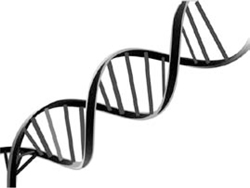Now I Know More (31 page)
Authors: Dan Lewis

Give a customer service number a ring and there's a good chance your phone call will be connected to a representative stationed outside the United States. However, there's an increasingly decent chance you'll find someone in the United States on the other end of the phone. The reason? Many companies have found a low-cost, domestic solution: prison inmates. According to CIO.com, prisoners earn about $1 an hour to provide level-one support to customers in need.

THE WOMAN WITH THE WRONG DNA
Embezzlement and on-the-job scams are pretty commonâespecially when compared to surrogacy scams. Typically, a surrogacy scam occurs when a female fraudster promises to carry a couple's fetus to term, but along the way pads the bill well beyond what one would have reasonably expected. Sometimes, it can get even worse.
And sometimes it's just a cruel trick of science.
Jamie Townsend and Lydia Fairchild were an unmarried couple who separated in 2002. When they split, Fairchild was pregnant with Townsend's child, and she requested government assistance in her home state of Washington. She claimed that she had two children, both from Townsend. Washington, to combat welfare fraud, required DNA tests from new applicants and their familiesâthe state wanted to make sure that the children are actually those of the claimantsâwhich Fairchild gladly agreed to provide.
But the DNA didn't match. According to the tests, the children Fairchild had been claiming were not her own. The authorities believed they had a more insidious scheme in front of them. They believed that Fairchild wasn't the children's actual mother but rather a surrogateâone who kept children for herself in order to collect welfare payments.
Fairchild protested, offering pictures of her two previous pregnancies, photos from the delivery room, and even the testimony of the delivering obstetrician. But those, the government argued, didn't matter. On the other hand, the DNA was dispositive. Fairchild, they concluded, was lying, which meant that the two children in her custody weren't hersâand her pregnancy . . . who knows? Thoughts of surrogacy fraud entered the picture. To prove it, the court ordered that an observer be present when Fairchild gave birth and that a DNA test occur in the first moment of the new baby's life.
Again, the DNA failed to match. Fairchild, it seemed, was somehow stealing eggs and, ultimately, children, all as part of some complicated con game. She was almost certain to spend untold years living in a prison cellâuntil her lawyers discovered the story of a Boston-area woman named Karen Keegan.
According to ABC News, Keegan needed a kidney transplant, and her family membersâincluding her childrenâunderwent tests to see if any of them could be a viable donor. Instead, doctors discovered that Keegan had different DNA than her children, a familiar story to Fairchild's attorneys. Keegan's doctors concluded that she had something called chimerism (from “chimera,” a part-lion, part-snake, part-goat from Greek mythology), a rarity to say the least. ABC News explained: “In human biology, a chimera is an organism with at least two genetically distinct types of cellsâor, in other words, someone meant to be a twin. But while in the mother's womb, two fertilized eggs fuse, becoming one fetus that carries two distinct genetic codesâtwo separate strands of DNA.” In Keegan's case, a sample from a thyroid nodule contained the same DNA as her children, even though most of the rest of her did not.
There are only a few dozen documented cases of chimerism in humans worldwide, and it turns out that Fairchild was one of them. Doctors administered a pap test, discovering DNA that matched her children. Fairchild had two different sets of DNA, explaining the previous mismatches.
She was deemed innocent of all charges levied against her.
If you want to tell two identical twins apart, a DNA test won't help, because they have the same DNA. What will help? Their belly buttons. Belly buttons are scars, as Wikipedia notes, and are not determined by genetics. (Fingerprints also work hereâidentical twins do not have identical fingerprintsâbut that's not as much fun.)

THE COINCIDENCE THAT MAY BE DESTINY
As of February 8, 1979, James Arthur SpringerâJim, as he went byâhad been twice married. His first marriage, to a woman named Linda, ended in divorce. His second wife was named Betty. Jim Springer grew up in Ohio and once owned a dog named Toy. He had a son named James Allan (although perhaps with one L). He was a chain-smoker who liked beer. In his garage he had a woodworking bench. He drove a Chevy, suffered from high blood pressure and migraines, and once served as a sheriff's deputy. His family lived on a quiet streetâtheirs was the only house on the block.
As of February 8, 1979, James Edward LewisâJim, as he went byâhad been twice married. His first marriage, to a woman named Linda, ended in divorce. His second wife was named Betty. Jim Lewis grew up in Ohio and once owned a dog named Toy. He had a son named James Allan (although perhaps with one L). He was a chain-smoker who liked beer. In his garage he had a woodworking bench. He drove a Chevy, suffered from high blood pressure and migraines, and once served as a sheriff's deputy. His family lived on a quiet streetâtheirs was the only house on the block.
As of February 8, 1979, Jim Springer and Jim Lewis had almost no knowledge of one another. They had met before, but only as infants. On February 9, 1979, the two met for the first time in nearly forty years.
They were identical twins, given up for adoption as one-month-olds, now reunited.
The shocking coincidence seems like that of myth, but it's almost certainly notâshortly after the twins' reunion,
People
magazine and
Smithsonian
magazine reported on the incredible confluence of genetically identical twins with anecdotally identical lives.
The two men piqued the curiosity of a researcher named Thomas J. Bouchard, a professor of
p
sychology and the director of the Minnesota Center for Twin and Adoption Research at the University of Minnesota. Bouchard studied their lives and similarities. Some of those parallel facts were purely coincidencesâthe two Jims' adoptive parents, who didn't share their DNA, named them both James. But Bouchard and his team concluded, as he stated in a research grant application, the evidence “continue[d] to suggest a very strong genetic influence on almost all medical and psychological traits.”
Bouchard was able to secure funding to investigate the link between twins further and, over the course of decades, was able to study many pairs of identical twins who were raised apart from one another. He discovered many examples of twins who, each having no knowledge of the other, nevertheless made strikingly similar decisions (although none were as well known as Jim Springer and Jim Lewis). All together, Bouchard concluded that “shyness, political conservatism, dedication to hard work, orderliness, intimacy, extroversion, conformity, and a host of other social traits are largely heritable.” That's not to say that we're slaves to our geneticsâcertainly not. However, they hold mysteries and relevancies that we are far from fully understanding.
Mark Twain wasn't a twin, but he often would tell people otherwise. According to the book
The Wit and Wisdom of Mark Twain
, the author would recount the tragicâbut fictional!âtale of his brother Bill, who drowned in a bathtub . . . maybe. Mark (really Samuel Clemens) and Bill were so similar, no oneânot even their motherâcould tell them apart. So no one was sure which of the two had died. A terrible story to make up? Yes, but Twain let listeners off the hook with his punch line: He'd say that he was the one who drowned.

THE WORST NAME TO HAVE IF YOU REALLY LIKE THE WATER
Famed writer Edgar Allan Poe wrote seventy poems and sixty-six short stories during his forty years on this planet, but he published only one novel. That book, titled
The Narrative of Arthur Gordon Pym of Nantucket
, is fiction, focusing on Pym's misadventures as a stowaway on a whaling ship.
It also makes for a very interesting warning for those wishing to take to seaâif your name is Richard Parker, at least.
The novel, published in 1838, involves an attempted mutiny on the whaling ship. Pym and two others repel the mutineers, killing or throwing overboard all but one. The spared mutineer, named Richard Parker, is kept aboard in order to help operate the ship. This turns out to be inadequate, as the ship capsizes, leaving the quartet shipwrecked and without adequate food. Parker suggests that cannibalism is the only way out, and they draw straws to determine the victim. Parker loses and becomes dinner.
Again, that is fiction. But in 1846âjust eight years after Poe published his novelâa real-life Richard Parker died in a shipwreck. He and twenty others were aboard the doomed
Francis Spaight
, which sank, killing all on board. This is, in and of itself, much ado about nothing; it is a mere coincidence and not a very good one at that, as it involves neither mutiny nor cannibalism.
But fast-forward a few decades to 1884, and the coincidence becomes downright creepy. A yacht named the
Mignonette
sank, and four peopleâjust like in the story of Arthur Gordon Pymâmade their way into a lifeboat. Just as in Pym's tale, the four found themselves lacking food and grew desperate. They did not draw straws, however; rather, two of the remaining three simply killed the youngest, a cabin boy who had fallen into a coma. All three then dined on the now-deceased seventeen-year-old. The cabin boy's name, of course, was Richard Parker.
As for mutiny, one needs to travel back in time to 1797, before Poe penned his novelâalthough there is little evidence that Poe had known about this incident. That year, another man named Richard Parker led a mutiny at the British naval base at Nore, commandeering a number of ships. As food began to run out, Parker ordered “his” fleet to head toward France. (Thankfully, there was no cannibalism this time.) The ship he was on followed this order but none of the other ships obeyed, and Parker was apprehended. He was hanged for treason.
This series of coincidences has not gone entirely unnoticed. In 2001, author Yann Martel published
The Life of Pi,
later made into a feature-length movie. It tells the story of a man who finds himself stranded on a lifeboat with a few animals, including a Bengal tiger. Martel paid homage to the shipwrecked men referred to previously by naming the tiger Richard Parker. While there is probably nothing to these coincidences, if your name is Richard Parker, you may want to stay away from boats.
The murder of Richard Parker on the
Mignonette
is famous for another reasonâthe later trial of Parker's murderers became a leading precedent in criminal common law jurisprudence. In the case,
Regina v. Dudley and Stephens
, the defendants argued that they committed the murder out of necessity, but the court ruled that necessity is no defense to murder. The case is now widely taught in law schools throughout the United States, but, if experience is any guide, few professors make reference to the coincidence of the victim's name.